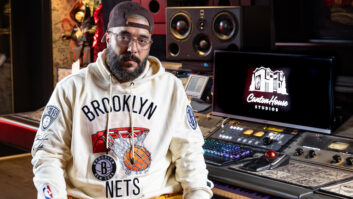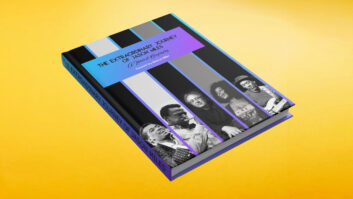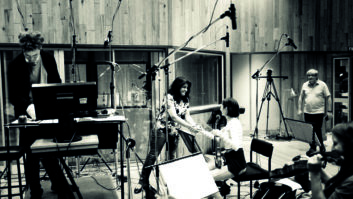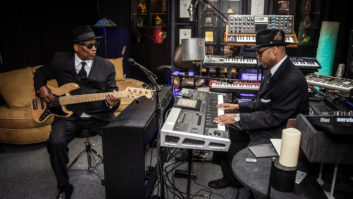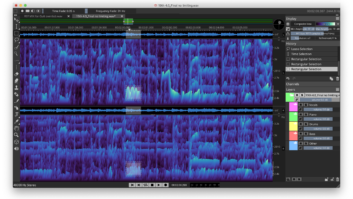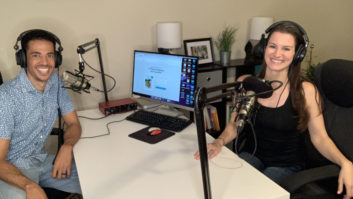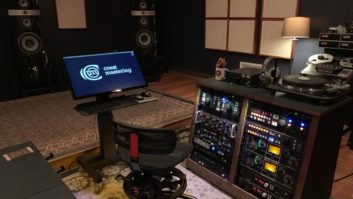For the music listener, lead vocals are the human element. The voice is like no other instrument in its ability to convey emotion, and to make or break a recording. If the vocal track is mediocre, then your project is doomed to failure; when it rocks, you’ve got a potential hit.
Of course, much of what makes recorded vocals really sing is intangible. The performer’s talent, mood and comfort level, and the strength and suitability of the song are essential to an effective vocal track, as any successful engineer or producer will acknowledge.
We talked some serious shop with three top recording engineers to find out about their approaches to recording vocals. While their techniques occasionally meet on common ground, there are surprising divergences in their approaches, too.
EARL COHEN
Earl Cohen has been recording and mixing music for more than 30 years, since he was a teenager back in the ’70s. His impressive discography includes releases by Tina Turner, Joe, Will Smith, Olivia, Willa Ford, John B and Changing Faces. He also has several Platinum and multi-Platinum albums to his credit, including Will Smith’s Willennium double-Platinum record for Columbia, Joe’s triple-Platinum My Name Is Joe (Jive) and Anita Baker’s double-Platinum Rhythm of Love (Elektra). Cohen was behind the board for Baker’s “I Apologize,” which won a Grammy Award for Best R&B Female Vocal Performance, and for The Temptations’ Grammy-winning “It’s Alright To Be Wrong” on their Ear-Resistible album. We caught up with Cohen at Sound on Sound (New York City), where he had recently recorded a Destiny’s Child single, “Bootylicious.”
Cohen expressed an affection for using vintage mics such as the Neumann U47, Telefunken 251 and AKG C-12 for recording vocals, preferring those that have had Bill Bradley modifications. But if he’s working with an artist for the first time and needs a “sure thing,” then he’ll typically head straight for a Sony C-800G tube condenser.
“I also like the [AKG] 414 TLII,” Cohen adds. “If you listen to any of the Joe records I worked on, that’s all TLII. I like the extra warmth of that mic on backgrounds. I also have certain cables I use, and certain mic pre’s I really like. The whole chain is what helps the microphone really speak. I’m very aware of, when a singer gets in the mic, what tone is working and what isn’t, and I start working around it from there.”
Does that mean he’ll make the singer back up a bit from the mic if he hears too much bass proximity effect? “No, actually I really like them in the mic,” Cohen insists. “The only time I like them off the mic is when they’re really belting out. I work everything in Pro Tools these days, so you have ‘X’ amount of headroom to go, and once you go over, man, it’s distortion.”
As far as working in the digital domain, I never track with a compressor on the vocals. Everyone’s always like, um, how do you do that? And I find the art really is getting the singer and the mic right.
— Earl Cohen
Cohen is not squeamish about adding EQ while tracking: “I’ll do a little tweaking, but I don’t go too crazy on it. I’ll add a little top usually. There are not many mics that don’t need a little top, especially because I really get the singer into the mic, so there’s always plenty of bottom. I usually keep a file on the settings; you can always come back to it, and at least you have the same EQ that you started with.
“As far as working in the digital domain,” Cohen continues, “I never track with a compressor on the vocals. Everyone’s always like, um, how do you do that? And I find the art really is getting the singer and the mic right. The dynamics won’t be as dramatic as you think they’ll be. But I want as much range as I possibly can [have].
“I’m very aware of not smacking the top,” he says. “I’ll definitely ride the gain to tape. I’m constantly checking out the gain.”
When it comes time to mix, Cohen will sometimes put a limiter on a vocal track’s channel insert to color the sound, but never simply to control the dynamics. “When I mix records, I’ve got a couple of limiters across the stereo bus, which controls the vocal totally. It never gives me trouble.”
That’s because Cohen goes over the vocal track with a fine-tooth comb long before mixdown. “I’ll go in there and dB lines and words up and down in Pro Tools, so when I’m done, my fader sits there. I’ll spend hours on it if I have to. It could be five or six hours that I just work on the vocal.”
He takes the same meticulous approach with equalization. “I like vocals to have a lot of air and a lot of presence, but big body. You can really feel the voice. I get a sound on the vocal, and then all the parts that get too dull or just don’t come across, those are the ones that I’ll go in and start working on. I have automated EQs going crazy. ‘Cause sometimes the singer just got in the mic weird, you know, or sometimes they are too close and they bottom out on a certain thing. Or it’s not present enough. I’ll re-EQ that section and just re-record it right on the track. I check it and make sure it’s working. Then when I get to mix mode, I’m always hearing something I have to fix.”
Cohen prefers using AKG K-141M and Sennheiser HD-250 headphones for a singer’s cue mix. “They seem to stick pretty tight to the person’s head,” he explains, “so it really keeps the leakage way down. And they’re really strong in the midrange, so the singer really can hear their full voice inside there. But I do make them always take one ear off — placing the cup against their head — so they can sing more in-tune.”
Unless a singer specifically requests something more elaborate, Cohen tends to keep lead vocals rather dry in the headphone mix. “I used to [add] a lot of effects on the vocals to give them a lot to work with, and some singers want it. But in the past year or so, I’m doing less with the vocal and leaving it pretty raw. This way, they really can hear their vocal performance.”
To build up a background vocal bed using one vocalist, Cohen might record up to 32 passes on separate tracks, submixing them down only after they’ve all been recorded. He has a specific method of working to avoid taking off-pitch BVs. “I’ll play the very first track and the new track I’m doing, but not all the tracks I recorded [in between]. It comes out way better. You can get fooled if you leave everything on. And I’ll definitely do a little compression and a lot more EQ’ing, because when you start stacking, you can get a buildup of mud.”
DOUG OBERKIRCHER
Doug Oberkircher started recording and mixing records in 1985, after serving as chief tech at The Hit Factory in New York City for a few years. He’s worked his magic behind the board for Spyro Gyra, Vanessa Williams, Dream Theater, Unspun, David Clayton Thomas, Jason Miles, Night Ranger, Arcade, Firehouse, Diving Pearls and Sting. Oberkircher’s deft engineering was part of the winning formula that garnered a Grammy (for Best Male Pop Vocal) for Sting’s “She Walks This Earth,” off the album A Love Affair — The Music of Ivan Lins.
Oberkircher is quick to praise both vintage and modern mics for recording vocals, citing the tube and FET Neumann U47s, the AKG C-12, and the AKG C-414 and B-TLII as favorite mics. “I’m also using this new Studio Projects tube mic, the T3 [distributed by PMI Audio],” he adds. “I really like it, and it’s very reasonably priced.”
A large-diaphragm mic can sound too dark on some singers, in which case Oberkircher won’t hesitate to use a small-diaphragm model. “Occasionally, I’ll use an AKG 451 with a cardioid capsule on it when I want a really bright, present sound. That’s kind of, like, an off-base [choice]. You won’t find so many people doing that, but I’ve had some success with it. I put it up against U87s and things like that, and it always turns out to be one of the ones that people like when initially hearing it.”
Time permitting, Oberkircher will A/B a couple of mics on a singer before making a choice. When recording, he usually prefers to have the artist stand very close to the mic. “I like to have the capsule pretty much right dead center, and I keep [the singer] about three or four inches away to begin. I’ll probably put a pop screen in front, depending on the singer and the style.”
If pops persist, then he’ll position the mic lower or use two Popper Stoppers. “If it’s getting to a point where you can’t do anything about it, then I’ll do something in the actual processing of the vocal later. I may go into a digital editor and just edit that stuff out. You can use a de-esser on a full-range-type setting, and sometimes that’ll catch some of it, but it doesn’t [completely] do it. I find if you get down on a pretty small scale in a digital editor, you can cut almost half the ‘P’ away, and it still doesn’t sound like it [was edited].
“I pretty much always track with compression,” he continues, “because I feel it actually helps get the dynamic range on tape. And it also helps the singer by giving them a little more punch and presence in their headphone.”
We talked about how getting the level just one or two dB hotter in the digital realm can make a tremendous difference in the resolution of the sound. “It sure does, yeah. And, again, unless you’ve got a wonderful singer who has a great, even tone, I don’t think you’re gonna find that you can get away without compression. And, in fact, I’m a big fan of compression on vocals. My all-time favorite would be the LA-2A. It gives a lot of control, and, unless you really slam it, you won’t really hear it too much. It’s a beautiful thing. I’ve also been using the Millennia Media TCL-2. I find that it doesn’t add any coloration. It’s just a very high-quality signal path. I usually start around 2:1, 3:1 at the most, on the compression [ratio] and keep it to around 3 dB of gain reduction or so, unless I really need more.”
Ever conscious of preserving signal clarity, Oberkircher is cautious about daisy-chaining two or more tube processors together. “If I’m gonna use a tube compressor, I might choose to stay away from a tube preamp stage,” he explains, “’cause I find that sometimes when you use them both, it starts to darken things a little much. You can get too much of that tube sweetness, and it turns into a little bit of distortion. There are exceptions to the rule. But, generally, if you’re gonna use a nice tube compressor, my choice would be to go to a Neve module or a Focusrite module — something solid-state — on the front end.” Oberkircher says he especially prefers the Neve 1093 and 1071.
“Unless I really have to, I’ll stay away from EQ while recording,” says Oberkircher. He’s really careful not to introduce any phase shift in the sound unless it becomes obvious that EQ is needed at mixdown. His one exception to the rule is he might EQ out a bass bump in the room’s frequency response while tracking.
Oberkircher is equally reluctant to de-ess vocals while tracking, fearing that too much sibilance could irreversibly be removed. He’s also careful not to derail the creative process by endlessly tweaking the sound while the performer is trying to lay down good takes.
Unless you’ve got a wonderful singer who has a great, even tone, I don’t think you’re gonna find that you can get away without compression.
— Doug Oberkircher
For the same reason, he’ll sometimes use the same mix he’s hearing in the control room for the vocalist’s cue mix. This helps him focus on getting a great vocal track, without being diverted by the need to monitor alternate mixes. When a separate cue mix is required, he’ll tend to emphasize traps, bass and a chordal instrument (the latter for pitch reference) in the headphones. “I think that [including] bass is important,” he adds, “because it helps people really set the foundation for their tuning. But I try to keep all the solo stuff out of there. That’s just going to get in the way.”
For miking background vocals, Oberkircher likes to use a Neumann U47 FET or U87. He’ll typically record a group of vocalists singing a unison part with a single omni mic. “If I’m doing a group of harmonies, say only three or four people, I might give them individual mics in a semicircle so that they face each other. I’ll probably add some compression on the individual channels for a little bit more control.”
When miking a choir, he’ll often use a separate cardioid mic on each section, supplementing with an ambient X-Y pair. Small-diaphragm B&K 4011s or AKG 451s are his first choice for use in X-Y setups.
ALLEN SIDES
The owner of the world-renowned Ocean Way Recording (Hollywood), Ocean Way Nashville and Record One Studios, Allen Sides is also in constant demand for his pre-eminent engineering skills. His discography reads like a who’s who of modern recording history, spanning an incredibly diverse range of musical styles. From Frank Sinatra to Green Day, Sides has done it all. The Grammy-winning engineer began his career recording jazz and R&B luminaries, such as Ella Fitzgerald, Duke Ellington, Count Basie, Ray Charles, and Earth, Wind & Fire. Recent album projects include the Goo Goo Dolls and Phil Collins. Sides’ engineering chops can also be heard on numerous soundtracks, including City of Angels and the first Star Trek movie. A consummate perfectionist in his choice of recording gear, Sides is an engineer’s engineer.
When asked what his favorite mics are for recording vocals, Sides is unequivocal. “I keep coming back to the [Neumann] U67. What works on one singer doesn’t necessarily work on another, but I would say that if I put up a 67, generally speaking, it’s going to work reasonably well on everybody. If I want something a bit more pop, I like the sound of the Sony C-800G.”
Sides usually picks around three mics that he thinks will work for a singer and A/Bs them to choose the one he’ll use, but he makes sure he works fast so as not to lose momentum. For a harsh-sounding singer with a huge dynamic range, “I’m very fond of the C-12A, because it has tremendous proximity effect in cardioid. You can put it a foot and a half to two feet away, and it still has rich low end.”
On the subject of favorite mic preamps, Sides excitedly recalls hooking up an original UA 2610 module (recently reissued, with slight modifications, by Universal Audio in a stand-alone, rackmount unit) to track Kenny Loggins’ vocals. “I was just floored by how rich, how amazing it sounded… I’m also fond of the Neve 1073, but mostly we’re using the in-house preamps in our consoles, which are our own creation.”
Sides will always give an experienced singer free rein to work the mic as he or she sees fit. If singers require some direction, however, then he’ll typically place them four to six inches away from the mic to begin with and will use a nylon windscreen to control pops.
He’s a firm believer in compressing vocals while tracking. “These days I’m recording most everything straight to Pro Tools,” he explains, “and using every bit of resolution makes a huge difference as to how the vocal sounds. I’m a big fan of the dbx 160 — the original one — and I like the old 1176 with the Class-A output. I also like the LA-2A.”
Sides notes that compressing a vocal can sometimes change its character such that some of its original, pristine nature can be lost. To make absolutely sure he captures the magic, he’ll sometimes take a two-pronged approach. “Sometimes what I’ll do is I’ll record the vocal uncompressed and I’ll record a compressed version simultaneously, using two different tracks. Then I can combine those things, and all the low-level stuff comes up on one side and the high-level stuff is unaffected. It’s a way to get lots of sustain.”
Sides likes to record background vocals with one mic, if possible. “But sometimes if I have six singers, I’ll take two C-12s and put three singers in front of each mic, and do double-mono passes. Or I’ll do a mono pass, another mono pass and a stereo pass. Sometimes I like to have as many stereo passes as I can. That allows me to have something to fool with later when I do 5.1.” He’ll often forego using compression on BVs, preferring to ride faders.
When asked about how he approaches the singer’s headphone mix, Sides becomes animated and answers with conviction. “I want it to sound like a finished record in the phones. To me, that’s everything. I’ll go out there, before they ever get there, have the headphones on, the reverbs, everything set, so that when they sing, it’s a finished record. They walk out there, put the headphones on and get excited. If they walk in and they put those headphones on, and they’re just knocked out, they’re gonna love you. I can’t say enough about it.”
Michael Cooper is a Mix contributing editor and owner of Michael Cooper Recording in beautiful Sisters, Ore.
